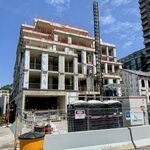I beg to differ. Yes CN would still own the corridor. But there's no reason VIA could not co-operate to build a third track, improve signalling, etc. I think what is preventing us from doing anything is the sticker shock of high speed rail. Selling the public on 2 billion for improved speed is a lot easier. I think the poor man's solution would achieve a lot. Cutting travel times by upto 40 mins - 1 hr just by ensuring that the current max speed can be sustained is nothing to scoff at. That would put VIA slightly below airlines in downtown to downtown block times. About 3.5 hrs by air. And about 4 hrs by VIA. At the current 5-6 hrs by VIA, rail is just uncompetitive.
There's absolutely no reason why VIA and CN couldn't co-operate to build a third track and do upgrades. They have done that many times. The problem, as I said, is that CN still controls the dispatching and their freight trains will still be tearing up the upgraded tracks. There is a long precedent in both Canada and the US of major publicly-funded upgrades being used by the freight railways for their own purposes (i.e. freight car storage) rather than for passenger service.
I agree that the sticker shock is an issue, but the sticker shock will be even more of an issue if we've already spent $2 billion on the existing line. Sometimes, you just have to bite the bullet. Everybody would have thought that the sticker shock on a $50 billion transit plan would have been prohibitive until it happened...
We forget that in many of those countries, expressways are outdated and expensive to upgrade, leading to rail being the practical alternative.
Well, the competition is more with air service, but okay, France and Spain are building massive high-speed networks despite some of the world's most extensive expressway networks.
Also, should real HSR come in, I'd be skeptical whether anything smaller than Kingston gets served.
Like I said, not every train has to stop at every station. In Spain, contrary to expectations, by far the most lucrative routes are out to mid-sized cities about 30-45 minutes out (at high speed) from Madrid. They run large numbers of dedicated commuter high speed trains that almost singlehandedly pay for the line. Kitchener and Guelph would be incredibly lucrative, while Port Hope/Cobourg and Belleville/Trenton also have significant potential.
I'd support that. Except I don't think VIA would be able to pay it off.... But it might be a consideration given the low interest rates these days. Possibly an extension of Dion's green infrastructure bonds idea.[/QUOTE]
Well, Bombardier builds planes as well, and they have been looking to sell the CSeries to a Canadian customer..... I don't think its the weakness of the HSR lobby, it's just the price tag and the optics of implementing HSR in the Quebec-Windsor corridor. The problem is that its really hard to sell a 12 billion dollar project to the rest of Canada, that only benefits Ontario and Quebec. 2-3 billion for small upgrades is much easier.....
Trust me. The airline lobby plays a major role in fighting high-speed rail, especially with its friends at Transport Canada.
Amortization works only so long as the system can make money. If it can barely get by like today, then VIA will need straight out grants to build infrastructure.
Virtually no high-speed network in the world is able to finance its capital costs, but most turn a significant operating profit. That's more than reasonable. The high speed line is a piece of infrastructure, just like a road or a streetcar line, none of which are expected to turn an operating profit, let alone overall profit.




